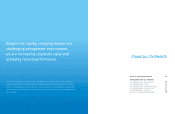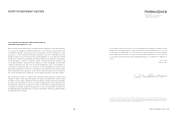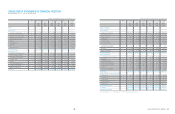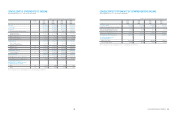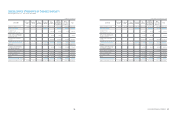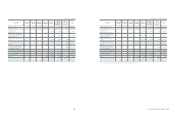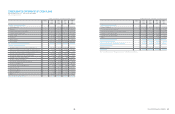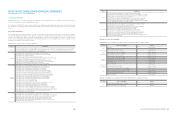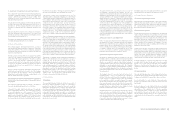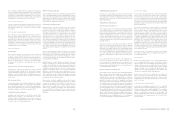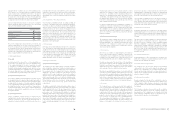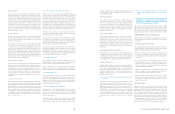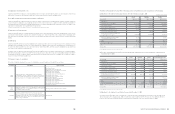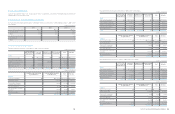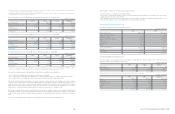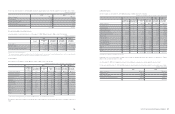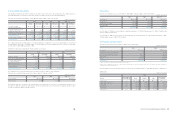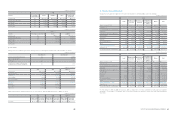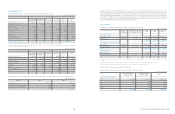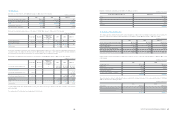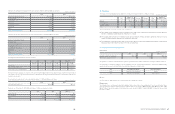Samsung 2010 Annual Report Download - page 25
Download and view the complete annual report
Please find page 25 of the 2010 Samsung annual report below. You can navigate through the pages in the report by either clicking on the pages listed below, or by using the keyword search tool below to find specific information within the annual report.
46 47
NOTES TO THE CONSOLIDATED FINANCIAL STATEMENTS
Capitalized interest is added to the cost of the underlying assets.
The acquisition cost of property, plant and equipment acquired
under a finance lease is determined at the lower of the present
value of the minimum lease payments and the fair market value of
the leased asset at the inception of the lease. Property, plant and
equipment acquired under a finance lease, leasehold improvements
are depreciated over the shorter of the lease term or useful life.
Land is not depreciated. Depreciation on other assets is calculated
using the straight-line method to allocate their cost to their residual
values over their estimated useful lives, as follows:
The assets’ residual values and useful lives are reviewed, and
adjusted if appropriate, at the end of each reporting period.
An asset’s carrying amount is written down immediately to its
recoverable amount if the asset’s carrying amount is greater than its
estimated recoverable amount. Gains and losses on disposals are
determined by comparing the proceeds with the carrying amount
and are recognized within the statement of income.
2.10 Intangible Assets
1) Goodwill
Goodwill represents the excess of the cost of an acquisition over
the fair value of the group’s share of the net identifiable assets
of the acquired subsidiary at the date of acquisition. Goodwill
on acquisitions of subsidiaries is included in intangible assets.
Goodwill is tested annually for impairment and carried at cost less
accumulated impairment losses. Impairment losses on goodwill are
not reversed. Gains and losses on the disposal of an entity include
the carrying amount of goodwill relating to the entity sold.
2) Capitalized development costs
The Company capitalizes certain development costs when outcome
of development plan is for practical enhancement, probability of
technical and commercial achievement for the development plans
are high, and the necessary cost is reliably estimable. Capitalized
costs, comprising direct labor and related overhead, are amortized
by straight-line method over their useful lives. In presentation,
accumulated amortization amount and accumulated impairment
amount are deducted from capitalized costs associated with
development activities.
3) Other intangible assets
Patents, trademarks, software licenses for internal use are
capitalized and amortized using straight-line method over their
useful lives, generally 5 to 10 years. Certain club membership is
regarded as having an indefinite useful life because there is no
foreseeable limit to the period over which the asset is expected to
generate net cash inflows for the entity; such asset is not amortized.
Where an indication of impairment exists, the carrying amount of
any intangible asset is assessed and written down its recoverable
amount.
2.11 Impairment of Non-financial Assets
Assets that have an indefinite useful life, for example goodwill, are
not subject to amortization and are tested annually for impairment.
Assets that are subject to amortization are reviewed for impairment
whenever events or changes in circumstances indicate that the
carrying amount may not be recoverable. An impairment loss is
recognized for the amount by which the asset’s carrying amount
exceeds its recoverable amount. The recoverable amount is the
higher of an asset’s fair value less costs to sell and value in use. For
the purposes of assessing impairment, assets are grouped at the
lowest levels for which there are separately identifiable cash flows
(cash-generating units). Non-financial assets other than goodwill
that suffered impairment are reviewed for possible reversal of the
impairment at each reporting date.
2.12 Borrowings
Borrowings are recognized initially at fair value, net of transaction
costs. Borrowings are subsequently measured at amortized cost;
any difference between cost and the redemption value is recognized
in the statement of income over the period of the borrowings using
the effective interest method. If the Company has an indefinite right
to defer payment for a period longer than 12 months after the end
of the reporting date, such liabilities are recorded as non-current
liabilities. Otherwise, they are recorded as current liabilities.
2.13 Employee Benefits
1) Retirement benefit obligation
The Company has either defined benefit or defined contribution
plans at respective company level. A defined contribution plan is a
pension plan under which the Company pays fixed contributions
into a separate entity. The Company has no legal or constructive
obligations to pay further contributions if the fund does not hold
sufficient assets to pay all employees the benefits relating to
employee service in the current and prior periods. A defined benefit
plan is a pension plan that is not a defined contribution plan.
Typically defined benefit plans define an amount of pension benefit
that an employee will receive on retirement, usually dependent
on one or more factors such as age, years of service and
compensation.
The liability recognized in the statement financial position in respect
of defined benefit pension plans is the present value of the defined
benefit obligation at the end of the reporting period less the fair
value of plan assets, together with adjustments for unrecognized
past-service costs. The defined benefit obligation is calculated
annually by independent actuaries using the projected unit credit
method. The present value of the defined benefit obligation is
determined by discounting the estimated future cash outflows using
interest rates of high-quality corporate bonds that are denominated
in the currency in which the benefits will be paid, and that have
terms to maturity approximating to the terms of the related pension
liability.
Estimated useful lives
Buildings and auxiliary facilities 15, 30 years
Structures 15 years
Machinery and equipment 5 years
Tools and fixtures 5 years
Vehicles 5 years
Actuarial gains and losses are recognized using the corridor
approach. The company recognizes actuarial gains and losses
in excess of a de minimis over the remaining working lives of
employees. The de minimis amount, which is also referred to as the
‘corridor limit’, is the greater of ten per cent of the present value of
the defined benefit obligation at the end of the previous reporting
period (before deducting plan assets) and ten per cent of the fair
value of any plan assets at that date.
For defined contribution plans, the Company pays contributions on
a mandatory, contractual or voluntary basis. The Company has no
further payment obligations once the contributions have been paid.
The contributions are recognized as employee benefit expense
when they are due. Prepaid contributions are recognized as an
asset to the extent that a cash refund or a reduction in the future
payments is available.
2) Profit-sharing and bonus plans
The Company recognizes a liability and an expense for bonuses
and profit-sharing, based on a formula that takes into consideration
the profit attributable to the company’s shareholders after certain
adjustments. The Company recognizes a provision where
contractually obliged or where there is a past practice that has
created a constructive obligation.
2.14 Provisions
Where there are a number of similar obligations, the likelihood
that an outflow will be required in settlement is determined by
considering the class of obligations as a whole. A provision is
recognized even if the likelihood of an outflow with respect to any
one item included in the same class of obligations may be small.
Provisions are measured at the present value of the expenditures
expected to be required to settle the obligation using a pre-tax rate
that reflects current market assessments of the time value of money
and the risks specific to the obligation. The increase in the provision
due to passage of time is recognized as interest expense.
When there is a probability that an outflow of economic benefits will
occur due to a present obligation resulting from a past event, and
whose amount is reasonably estimable, a corresponding amount of
provision is recognized in the financial statements. However, when
such outflow is dependent upon a future event, is not certain to
occur, or cannot be reliably estimated, a disclosure regarding the
contingent liability is made in the notes to the financial statements.
2.15 Leases
The Company leases certain property, plant and equipment.
Lease of property, plant and equipment where the Company has
substantially all the risks and rewards of ownership are classified
as finance leases. Finance leases are capitalized at the lease’s
commencement at the lower of the fair value of the leased property
and the present value of the minimum lease payments. Each lease
payment is allocated between the liability and finance charges
so as to achieve a constant rate on the outstanding balance.
The corresponding rental obligations, net of finance charges, are
included in other long-term payables. The interest element of the
finance cost is charged to the statement of income over the lease
period so as to produce a constant periodic rate of interest on the
remaining balance of the liability for each period. The property, plant
and equipment acquired under finance leases is depreciated over
the shorter of the useful life of the asset and the lease term.
Leases in which a significant portion of the risks and rewards of
ownership are retained by the lessor are classified as operating
leases. Payments made under operating leases (net of any incentives
received from the lessor) are charged to the statement of income on
a straight-line basis over the period of the lease.
2.16 Derivative Instruments
All derivative instruments are accounted for at fair value with the
resulting valuation gain or loss recorded as an asset or liability. If the
derivative instrument is not designated as a hedging instrument, the
gain or loss is recognized in the statement of income in the period
of change.
Fair value hedge accounting is applied to a derivative instrument
with the purpose of hedging the exposure to changes in the
fair value of an asset or a liability or a firm commitment (hedged
item) that is attributable to a particular risk. Hedge accounting is
applied when the derivative instrument is designated as a hedging
instrument and the hedge accounting criteria have been met. The
gain or loss, both on the hedging derivative instrument and on
the hedged item attributable to the hedged risk, is reflected in the
statement of income.
2.17 Dividend Distribution
Dividend distribution to SEC’s shareholders is recognized as a
liability in the Company’s consolidated financial statements in the
period in which the dividends are declared.
2.18 Share-based Compensation
The Company uses the fair-value method in determining
compensation costs of stock options granted to its employees and
directors. The compensation cost is estimated using the Black-
Scholes option-pricing model and is accrued and charged to
expense over the vesting period, with a corresponding increase in a
separate component of equity.
2.19 Revenue Recognition
Revenue comprises the fair value of the consideration received or
receivable for the sale of goods and services in the ordinary course
of the Company’s activities. Revenue is shown net of value-added
tax, returns, rebates and discounts and after eliminating sales within
the Company.
The Company recognizes revenue when specific recognition
criteria have been met for each of the Company’s activities as
described below. The Company bases its estimates on historical
results, taking into consideration the type of customer, the type of
transaction and the specifics of each arrangement.


